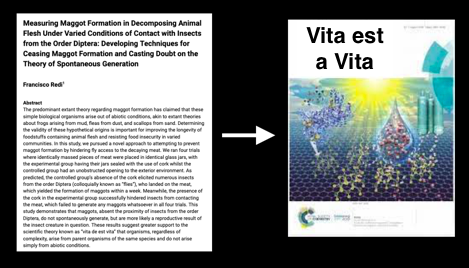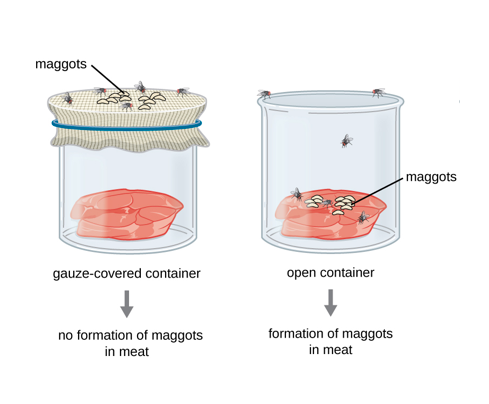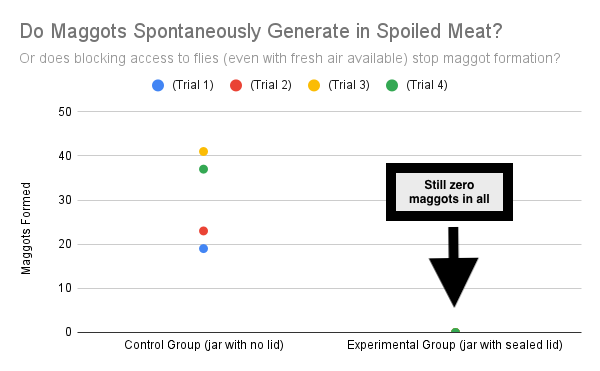Redi's Published Results are ATTACKED
Francesco Redi, being a good little scientist, then wrote up his results and submitted them to a scientific journal publication.

Then, if the scientific journal is a reputable institution, they perform a double-blind peer review where multiple experts (usually three) read the study, critique it, and suggest revisions to the scientific paper if it is to be published in the journal. Sometimes, the peer-reviewers will outright recommend that the study is not fit for publication in the journal, especially if they see serious flaws in the experiment's design, implentation, and/or interpretation.
Let's pretend that the Vita est a Vita (Latin for "Life comes from Life") scientific journal ultimately published Francesco Redi's study. Would that be the end of it?
Most certainly not.
Other scientists would read the published scientific article. And if I were a scientist who believed in the theory of spontaneous generation, I would probably begin trying to poke holes in Redi's experiment. And often, scientists will respond to published articles by writing letters to the editor(s) of the scientific journal.
For example:
-------------------------------
LETTER TO THE EDITORS OF VITA EST A VITA
Last issue, this journal published Francesco Redi's experiment about maggot formation in rotting meat. The author of this study promoted the foolhardy conclusion that -- since he stopped maggot formation by corking meat into a glass jar and preventing insects from touching the meat -- he had disproved the theory of spontaneous generation.
But alas, if the author of the study (and its peer reviewers) were better read in the scientific studies surrounding the theory of spontaneous generation, they would have realized that much evidence suggests that a consequential abiotic factor in the formation of simple organisms is the ample provision of fresh air circulation.
Thus, it is very possible that the utilization of the sealed cork lid ceased maggot formation NOT BECAUSE insect contact was prevented BUT BECAUSE air flow circulation was hindered. If Redi seeks to make a more compelling case against spontaneous generation, I highly recommend that he design an experiment that prevents insect contact whilst also concomitantly allowing fresh air circulation.
-- Dr. Canseco Guitarra of Bizarro University
-------------------------------
Now Francesco Redi could have simply dismissed this cricitism and went onward to the next experiment he wished to perform. But Francesco Redi was a good scientist, so he took this criticism into consideration. And so, he designed a follow-up experiment, where everything was exactly the same, but he replaced the corked lid with a cloth netting that would allow the circulation of fresh air whilst prohibiting insect contact with the meat.

This follow-up experiment yielded similar results (although they were not exactly identical). The experimental group (with the cloth netting over the opening) featured meat that failed to yield any maggots, despite the presence of air circulation and fresh air. And the control group, where flies had free access to the meat in the jar, once again yielded maggots.


Redi's experimentation readily proved that maggots can be prevented from forming in meat if flies are not allowed to land on the meat. Without flies, maggots will not "spontaneously generate" and the absence/presence of fresh air does NOT affect the outcome.
Nonetheless, the theory of spontaneous generation as a whole was not disproven in the hearts of all scientists until much later. Upon the discovery of microscopic organisms (formerly known as "animalcules"), many scientists believed that spontaneous generation was how bacteria and mold formed.
This belief lasted until 1862, when Louis Pasteur performed a series of experiments that demonstrated that bacteria only formed from pre-existing bacterium. Almost a full two hundred years later!